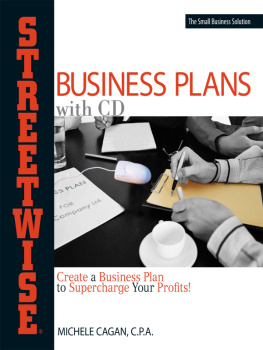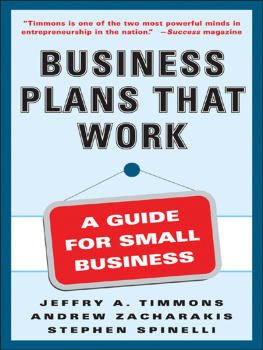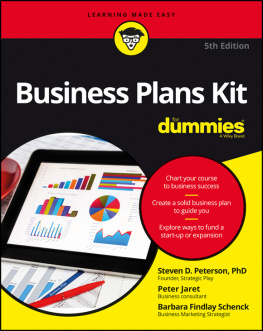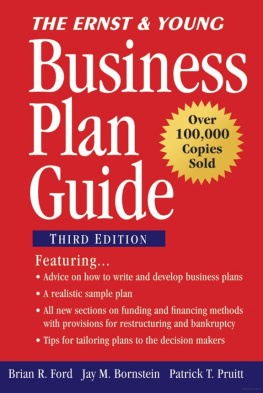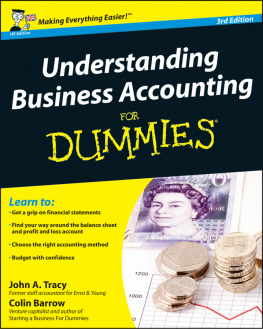
Copyright 2011 by Andrew Zacharakis, Stephen Spinelli, and Jeffry A. Timmons. All rights reserved. Except as
permitted under the United States Copyright Act of 1976, no part of this publication may be reproduced or distributed
in any form or by any means, or stored in a database or retrieval system, without the prior written permission of the
publisher.
ISBN: 978-0-07-175257-2
MHID: 0-07-175257-9
The material in this eBook also appears in the print version of this title: ISBN: 978-0-07-174883-4,
MHID: 0-07-174883-0.
All trademarks are trademarks of their respective owners. Rather than put a trademark symbol after every occurrence
of a trademarked name, we use names in an editorial fashion only, and to the bene t of the trademark owner, with
no intention of infringement of the trademark. Where such designations appear in this book, they have been printed
with initial caps.
McGraw-Hill eBooks are available at special quantity discounts to use as premiums and sales promotions, or for use
in corporate training programs. To contact a representative please e-mail us at bulksales@mcgraw-hill.com.
TERMS OF USE
This is a copyrighted work and The McGraw-Hill Companies, Inc. (McGrawHill) and its licensors reserve all
rights in and to the work. Use of this work is subject to these terms. Except as permitted under the Copyright Act of
1976 and the right to store and retrieve one copy of the work, you may not decompile, disassemble, reverse engineer,
reproduce, modify, create derivative works based upon, transmit, distribute, disseminate, sell, publish or sublicense
the work or any part of it without McGraw-Hills prior consent. You may use the work for your own noncommercial
and personal use; any other use of the work is strictly prohibited. Your right to use the work may be terminated if you
fail to comply with these terms.
THE WORK IS PROVIDED AS IS. McGRAW-HILL AND ITS LICENSORS MAKE NO
GUARANTEES OR WARRANTIES AS TO THE ACCURACY, ADEQUACY OR COMPLETENESS OF OR
RESULTS TO BE OBTAINED FROM USING THE WORK, INCLUDING ANY INFORMATION THAT CAN BE
ACCESSED THROUGH THE WORK VIA HYPERLINK OR OTHERWISE, AND EXPRESSLY DISCLAIM ANY
WARRANTY, EXPRESS OR IMPLIED, INCLUDING BUT NOT LIMITED TO IMPLIED WARRANTIES OF
MERCHANTABILITY OR FITNESS FOR A PARTICULAR PURPOSE. McGraw-Hill and its licensors do not
warrant or guarantee that the functions contained in the work will meet your requirements or that its operation
will be uninterrupted or error free. Neither McGraw-Hill nor its licensors shall be liable to you or anyone else
for any inaccuracy, error or omission, regardless of cause, in the work or for any damages resulting therefrom.
McGraw-Hill has no responsibility for the content of any information accessed through the work. Under no
circumstances shall McGraw-Hill and/or its licensors be liable for any indirect, incidental, special, punitive, consequential o r
similar damages that result from the use of or inability to use the work, even if any of them has been advised of the
possibility of such damages. This limitation of liability shall apply to any claim or cause whatsoever whether such
claim or cause arises in contract, tort or otherwise.
v
Contents
Preface vii
1 Entrepreneurs Create the Future 1
2 Before You Start Planning, Ask the Right Questions 25
3 Getting Started 43
4 Industry: Zoom Lens on Opportunity 57
5 Company and Product Description: Selling Your Vision 79
6 Marketing Plan: Reaching the Customer 89
7 Operations and Development: Execution 103
8 Team: The Key to Success 119
9 The Critical Risks and Offering Plan Sections 127
10 Financial Plan: Telling Your Story in Numbers 137
11 Conclusion 157
Appendix 1: Quick Screen Exercise 169
Appendix 2: Business Planning Guide Exercise 173
Appendix 3: Sample Presentation 179
Index 187
About the Author 197
vii
Preface
We have worked with over a thousand students of entrepreneurship,
invested in a score of companies, and created a dozen start-ups. Weve
worked in, consulted for, and advised businesses across several continents
and innumerable industries. Our experiences have brought us a special
appreciation of the value of business planning.
Some people will argue that writing a business plan is time consum-
ing and obsolete the minute it emerges from the printer. They miss the
point. The process of creating the plan is very important. The business
plan isnt just a tool to raise capital; it is a process that helps entrepreneurs
gain deep knowledge about their ideas. The discipline that the planning
process provides helps you assess the nature of the opportunity and cre-
ates a greater ability to shape a business model to exploit it.
Will your business model change once you start the business? Prob-
ably. Going through the business planning process will result in modi-
cations even before you launch the business. But, we guarantee that the
act of business planning will save you countless hours and sums of money
in false starts simply because it will help you anticipate the resources
required and the pitfalls that may arise. Even though business planning
cant help you anticipate every potential problem, the deep learning will
more than offset the cost of writing the plan.
Book Design
This book will illustrate a proven and innovative approach to writing a
business plan. Each chapter will introduce different components of the
viii Preface
planning process. Also, each chapter will illustrate the concepts by high-
lighting Lazybones, an actual company that was planned and launched
and is currently operating. The key feature of this section is the comments
in the margins that point out various aspects of the plan that are good
and others that need work. As you progress through the book, you will
become familiar not only with the process but also with the Lazybones
opportunity.
A word of caution: Your business plan will vary from the Lazybones


